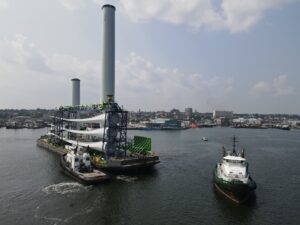By Jennifer Carpenter and Anne Reynolds.
Attention to offshore wind often focuses on the turbines themselves—how many are installed and how many gigawatts of power are online. But the real story is that the heartland of America is building vessels and driving investment across the U.S., and not just on the East Coast.
Offshore wind development encompasses many parts of the country. Across red states and blue states, companies are investing in their communities to build out the supply chain and meet growing electrical demand.
In particular, we see this in the U.S. maritime sector, which touches every state in the nation, and is critical to building and maintaining these offshore wind projects. Whether building new vessels, retrofitting existing vessels, or investing in partnerships with educational institutions to train workers, there is a greater story to tell.
Shipyards in Wisconsin, Texas, Mississippi, Louisiana, and Florida are building and retrofitting vessels that will anchor the growth of offshore wind projects, ensuring stability for the sector. Per the latest analysis, 30 maritime vessels for offshore wind are being built or are in service, 12 are on order, and four have undergone large retrofits for use in this growing industry. The companies operating these vessels are finding new work in this new type of offshore energy, using U.S. shipyards, and employing American mariners. This massive investment is made possible because of America’s shipyard capacity and talent.
U.S. vessels are integral to the construction of these wind farms. To take just one example, the Vineyard Wind 1 project off the coast of Massachusetts uses a U.S.-built, crewed, and flagged Service Operation Vessel (SOV), the Cade Candies, from the Gulf of Mexico. The same project is also using tugs and barges, the Nicole Foss and the Foss Prevailing Wind, to bring offshore wind components out to the site. But it is not just those vessels. Guice Offshore’s GO Liberty and Coast Line Transfers Capt. Les Eldrige are also supporting the construction. The SEACOR Hawk is helping commission Vineyard Wind 1’s offshore substation, and the Hornbeck Mystique is installing the transmission cables. A diverse fleet is critical to projects like these.

In addition, the U.S. is right around the corner on building specialized vessels that could further propel growth for the sector. Dominion Energy’s Wind Turbine Installation Vessel Charybdis under construction in Texas has been heralded as carrying “the key to unlocking more green energy.” In Pennsylvania, Philly Shipyard is constructing the Acadia for Great Lakes Dredge and Dock that will further strengthen the U.S. supply chain. These ships are built with tens of thousands of tons of U.S. steel from states like Alabama, West Virginia, and North Carolina.
While the massive construction vessels make news, the continuous operation and maintenance of offshore wind power projects carry even more opportunities for the American maritime workforce. Over two dozen Crew Transfer Vessels and seven Service Operation Vessels have been built and retrofitted in the United States to keep U.S. offshore wind installations operating safely and efficiently.
St. Johns Shipyard in Florida has eight Crew Transfer Vessels either in service, under construction, or ordered. Edison Chouest delivered the ECO Edison for Orsted and a second SOV for Equinor’s Empire Wind 1 project is under construction in Louisiana. Florida’s Crowley is building an SOV for the Dominion Coastal Virginia Offshore Wind project in Wisconsin.
Contracts like these will provide long-term jobs for U.S. mariners over the 20-30-year lifetime of an offshore wind energy project, which means increased investment in America’s maritime workforce. And that investment also benefits our national security— in times of conflict, American mariners can be called upon to support our armed forces and act as eyes and ears for our law enforcement agencies on domestic waterways.
There is real growth in the U.S. offshore wind market, with one project completed just this year, the South Fork Wind Project, and four now under construction from Massachusetts to Virginia: Vineyard Wind 1; Revolution Wind to serve Connecticut and Rhode Island; Sunrise Wind to serve New York; and the Coastal Virginia Offshore Wind Project. And there is much more to come – the offshore wind industry is expected to grow from several thousand offshore wind jobs today to more than 50,000 over the next decade.
To meet rising electrical demand, America needs offshore wind. To enable offshore wind development, America needs U.S. maritime. New vessels, retrofits, and existing ships are creating new opportunities for U.S. maritime, and the ongoing expansion of the U.S. offshore wind sector translates into more American jobs both on and off the water, for every part of the country.
Jennifer Carpenter is President and CEO of American Waterways Operators.
Anne Reynolds is Vice President for offshore wind with the American Clean Power Association.
Come Aboard
"*" indicates required fields
